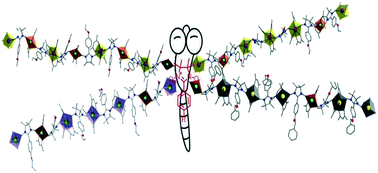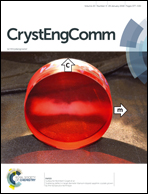Nitronyl nitroxide bridged 3d–4f hetero-tri-spin chains: synthesis strategy, crystal structure and magnetic properties†
Abstract
Three series of 2p–3d–4f one-dimensional chains based on different substituted nitronyl nitroxide ligands have been synthesized, namely [(NIT-PhOEt)2Cu(hfac)2Dy(hfac)3]2·C7H16 (1) and [(NIT-PhOEt)4{Cu(hfac)2}{Dy(hfac)3}3]·H2O (2) (NIT-PhOEt = 2-(4′-ethoxyphenyl)-4,4,5,5-tetramethylimidazoline-1-oxyl-3-oxide), [(NIT-PhOAll)4{Cu(hfac)2}{Ln(hfac)3}3] (LnIII = Ho 3, Er 4, Yb 5; NIT-PhOAll = 2-(4′-allyloxyphenyl)-4,4,5,5-tetramethylimidazoline-1-oxyl-3-oxide) and [(NIT-PhOBz)4{Cu(hfac)2}{Ln(hfac)3}3] (LnIII = Pr 6, Sm 7, Eu 8; NIT-PhOBz = 2-(4′-benzyloxyphenyl)-4,4,5,5-tetramethylimidazoline-1-oxyl-3-oxide). The crystal structures of complex 1 reveal that it is developed from alternating Dy(hfac)3 units and Cu(hfac)2 units bridged by NIT-PhOEt radicals coordinated by their NO groups. Complexes 2 and 3–8 are isostructural possessing 1D chains with repeating [Cu–Rad–Ln–Rad–Ln–Rad–Ln–Rad] moieties. The magnetic properties of all complexes were studied. For complexes 1 and 2, their magnetic behaviors are attributed to the relationship between the exchange couplings for metal ions and the crystal field effect for Dy. For complexes 3–5, the ferromagnetic exchange couplings between radical ligands and metal ions are dominated by the stronger contributions of the crystal field effect. For complexes 6–8, the magnetic behaviors depend on the metal interaction and thermal depopulation of the excited levels for lanthanide ions. AC magnetic susceptibilities were measured for complexes 2, 4 and 7; however, none of them exhibits single-chain magnetism behavior.



 Please wait while we load your content...
Please wait while we load your content...